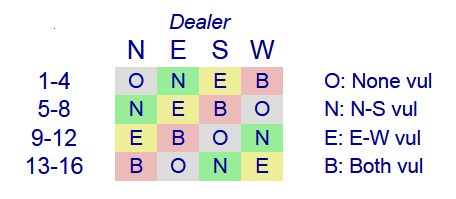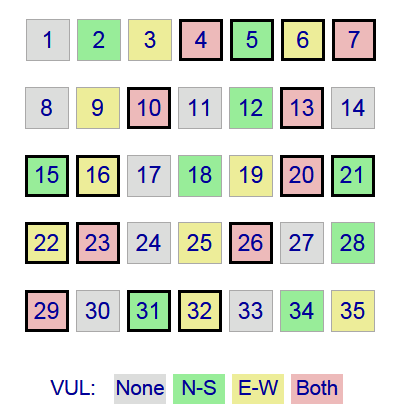
Pattern Is Inequitable
 |
The Board Vulnerability Pattern Is Inequitable |
Here is the long-established configuration for the first sixteen duplicate boards:

I call this the BONE CHART. Every combination of dealer
and vulnerability occurs exactly once in the set. The pattern is
repeated for each subsequent group of sixteen boards
(17-32, 33-48, etc.). (Among other things, a mental image
of this chart can serve as a quick reference for determining a board's
vulnerability.)
Consider firstly the format of Chicago —
a game of four-board segments featuring duplicate-style
scoring. Many players conveniently adopt the setup included with
Boards #1-4. From another perspective, those specs are as
follows:
So the dealer is vulnerable only one time in four; and I ask you, "Is that equitable?" I contend that it is not.
For example, an aggressive pair that is fond of light opening preempts
when Non-Vul would be better-off sitting North-South,
because there would be two opportunities to do their thing while the
opponents would have just one. Also, a pair playing Strong Notrumps
Vul and Weak Notrumps Non-Vul also would benefit from sitting
North-South on this set of boards, assuming that they would like to
open with a Weak 1NT as much as possible (which is the whole idea,
after all).
Many other Chicago players, who are not utilizing actual
duplicate boards, commonly agree on a vulnerability rotation of
'None / Dealer / Dealer / Both'. That pattern, however,
clearly suffers from the same problem, but in reverse; for now the dealer
is vulnerable three times in four. In such a game, the more
conservative pair would do best to sit North-South, forcing the
opponents to start life vulnerable nearly every time.
The fairness issue regarding table positions could be resolved by starting
each rotation of four boards at a different table-position; in other
words, hands #1-4 begin with North as dealer, hands #5-8 with
East the first dealer, etc. That would not fix the overall bias of
the session, however; for it still would favor the more conservative pair
overall with the dealer being vulnerable three-fourths of the time.
Those players using duplicate boards could even the chances by playing
sixteen hands. Using another group of four consecutively numbered boards,
however, would not resolve the matter; in fact, if you were to try
Boards #4-7, you would find the dealer to be vulnerable on every
hand!
The solution to this problem, though, is elementary. Simply adopt a
vulnerability pattern of 'None / Dealer / Both / Non-dealer',
or any rotation of that series including backwards. Now, the dealer
is vulnerable twice and non-vulnerable twice! What a concept.
If using duplicate boards, this 'fix' can be implemented by rearranging the boards themselves. The following groupings of four boards satisfy the requirements, while maintaining the four vulnerability patterns and enabling each player to deal a hand:
There are other workable matrices as well, but do you care? If not, perhaps the next discussion will have some meaning for you.
Now we are down at the Swiss Teams, where it is common to play
7-board rounds. Another chart is in order, showing the specs
for the standard groupings of boards. The highlighted boxes show the board
numbers on which the dealer is vulnerable:

One anomaly of the configuration is that the set of Boards #8-14
will feature more overall 'action' in the long run due to increased
opportunities for preempts as dealer. So the next time your team
needs to catch up to the leader in the late matches, it would be
mathematically advantageous to be assigned tables with Boards #8-14
lying on them. The likelihood of achieving the needed swing-results
would be significantly better than if playing, say, Boards #1-7 or
#15-21.
Granted, it is unlikely that this insight will change any director's behavior,
and no League officials will lose any sleep over it either; but the next time you
observe an event-contender skulking about just prior to the start of the last
match with Boards #8-14 in his hand, you will know why.
In any case, you heard it here first — at
Ted's World.